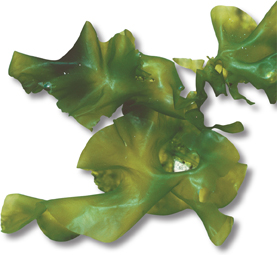Green Algae 
KEY CHARACTERISTICS
The green algae are plants that do not make embryos. All other plants form embryos as part of their life cycle. The green algae include both unicellular and multicellular species, and they are primarily aquatic.
Organization Single cells, colonies, and a few truly multicellular species
Movement Many swim using whiplike flagella.
Water Transport Water diffuses in from the environment.
Reproduction Asexual and sexual, with gametes and spores; some species show alternation of generations.
The three most diverse groups of green algae are profiled below.
CHLOROPHYTES: Classic green algae
These algae usually live as single cells, like Chlamydomonas, or in colonies, like Volvox. They are found in both fresh and salt water, and some species are even known to live in arctic snowbanks.

Chlamydomonas is a unicellular green alga. Each cell has two flagella, which are used in movement. (SEM 3000X)
CHAROPHYTES: Stoneworts
Among the green algae, the charophytes (KAHR uh fyts) are the closest relatives of more complicated plants. They are mostly freshwater species. Their branching filaments may be anchored to the substrate by thin rhizoids.

Chara with antheridia (sperm-producing structures) visible
ULVOPHYTES: Sea lettuces
The ulvophytes are large organisms composed of hundreds or thousands of cells. Most form large, flattened green sheets and are often simply called seaweed. They show both haploid and diploid phases in their life cycle, but in many species, such as the common sea lettuce, Ulva, it is difficult to tell the two phases apart.

Clumps of Spirogyra, a filamentous green alga, are commonly called water silk or mermaid's tresses.

Ulva lactuca
Table of Contents
- Formulas and Equations
- Applying Formulas and Equations
- Mean, Median, and Mode
- Estimation
- Using Measurements in Calculations
- Effects of Measurement Errors
- Accuracy
- Precision
- Comparing Accuracy and Precision
- Significant Figures
- Calculating With Significant Figures
- Scientific Notation
- Calculating With Scientific Notation
- Dimensional Analysis
- Applying Dimensional Analysis




